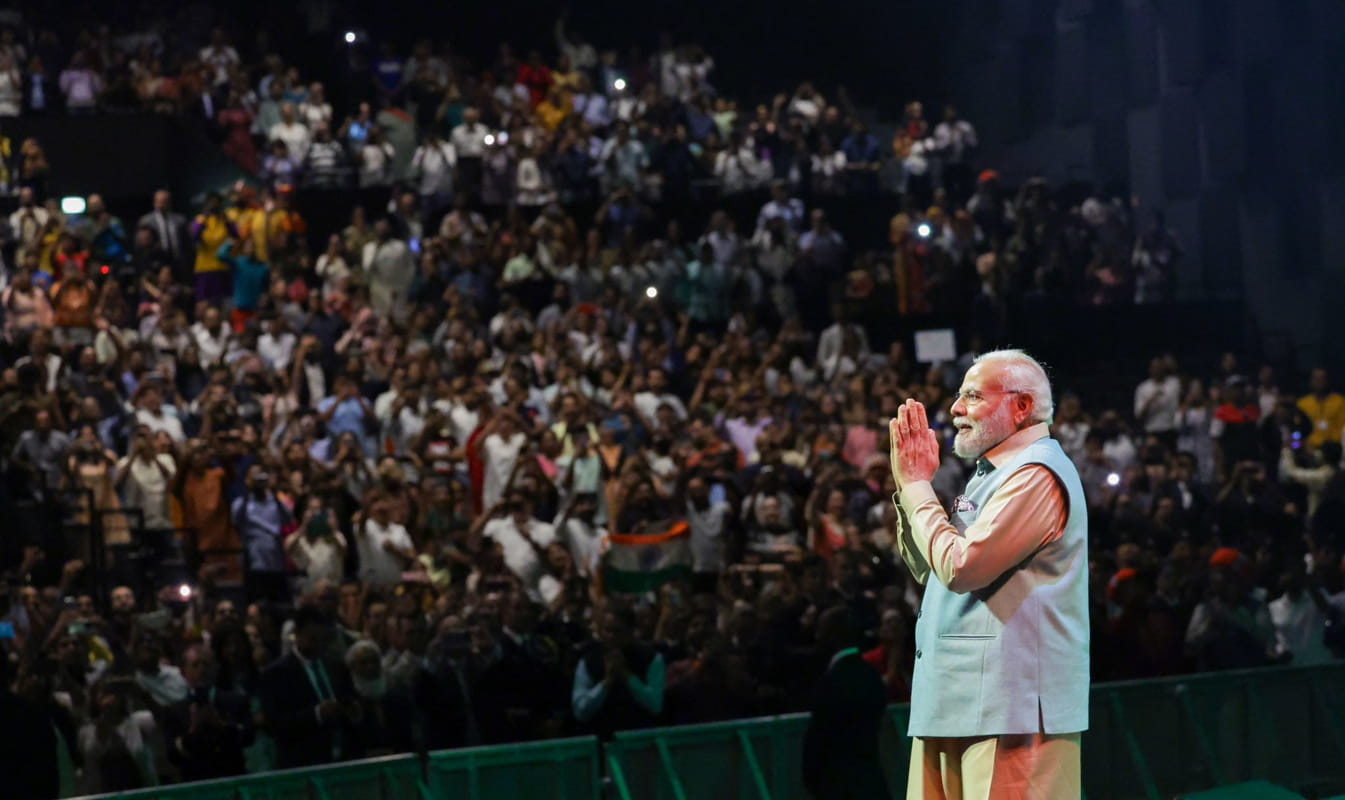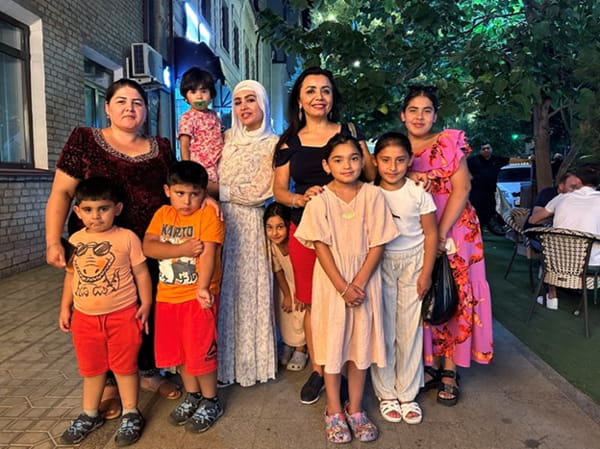
Indian Prime Minister Narendra Modi greets the Indian diaspora in Paris, July 2023. | pmindia.gov.in.
Introduction
Migration today constitutes a major force at work in the global development dynamic, one that is transforming countries of origin due to remittances and return migration as well as diaspora engagement.[1] We examine the critical role these mechanisms have in a unified diaspora strategy with the example of India which provides one of most cutting edge strategies to be admired and pursued by others.
This analysis of India’s success implies that engaging diaspora communities can be an important tool in the development strategies for governments in Central Asia in their efforts to foster economic and social development.
Migration and Development
Migration influences the development in countries of origin primarily through three main mechanisms: remittances, return migration and diaspora engagement. The development consequences of economic remittances are, perhaps, the most well studied facet of migration and development. Remittances help hundreds of millions to a living standard above what traditional development assistance can achieve where migrants come from.[2]
Migration, apart from providing economic remittances, also helps in the movement of social remittances like knowledge and ideas or practices, identities and with them social capital.[3] With the return migration, local industrial and technological development will be more affected. Migrants, in this sense, can be agents of innovation and change who can harness the knowledge base, competences and risk-taking ethos they develop abroad to help grow their home economies.
Participation of diasporas in the development of their home countries is a measure that voluntarily links migration and development. Also, migrants and their offspring seem to rely on an important amount of valuable resources and knowledge that can be mobilised for local development. Besides philanthropy and investment in enterprise development, start-ups and trade networks, diaspora mobilisation can result in more social as well as economic remittances.[4]
Sending countries are placing more emphasis on creating different types of platforms that governments can work through to build partnerships, mentoring programs and ongoing relationships with the diaspora as well.
India’s Comprehensive Diaspora Engagement Strategy
India has served as a model for nations in their attempts to engage their respective diaspora communities. India, acknowledging the vast amounts of knowledge, skills, and potential that lay dormant within its diaspora, has, within the last twenty years, put a lot of time, money, and effort into building up good relations with Indians overseas. Even the word diaspora has changed its meaning from just Non-Resident Indian (NRI) and Person of Indian Origin (PIO) to being vital partners in India’s development.
In 2004, the Indian government established the Ministry of Overseas Indian Affairs (MOIA),[5] which was a significant step because it showed that the government was willing to institutionalise these relationships. The MOIA was originally created to provide an organised framework for keeping and nurturing ties with the Indian diaspora, with an interest in welfare and reciprocity in economic and political spheres.
One of the major forums for diaspora involvement is the Pravasi Bharatiya Divas (PBD) or Non-Resident Indian Day. It started in 2003, and it is an annual event that is meant to promote the idea of a “global Indian family”.[6] PBD is now one of the major forums for diaspora interaction, with Indian government officials and PIOs alike participating.
It is a place to talk about the hardships of the Indian migrants as well as their successes.
The Pravasi Bharatiya Samman Award (PBSA) is presented at this event and honours individuals or organisations led by them for their outstanding achievements in different fields ranging from business to healthcare to education to philanthropy.[7] The PBSA recognition has also empowered Indian communities overseas to become unofficial ambassadors of India in the sense that they not only add to India’s image abroad but also to its development at home.
India has gone a step further in granting political participation to its diaspora by looking into the possibility of parliamentary representation for NRIs. This is still a controversial issue, but it is an indication of India’s changing perception of its diaspora, not just as expatriates, but as agents of development.
This thought has been somewhat influenced by the huge remittances that comes into India every year, over $89 billion in 2021 alone, making India the Number 1 remittance-receiving country in the world (India received the highest ever foreign inward remittance in a single year of approximately $89 million in FY 2021-22).
In this way, India hopes to provide more political participation for these people who contribute so much to the Indian economy, and in turn, hopes to allow these contributors to have a say in India’s government, so that the diaspora and the state can have a type of symbiotic relationship.
Diaspora’s Role in India’s Development and Global Image
Not only is the idea of a “global Indian family” symbolic but strategic for India. And then there is the issue of the diaspora which is becoming more and more important to India's foreign policy. The country realises that as it tries to elevate itself in the world, it can do this most effectively through expatriates who are well connected and powerful and can help with diplomatic and trade relationships.
Prime Minister Narendra Modi has repeatedly stated that the diaspora plays a crucial role in India's foreign affairs. For example, at the 2024 PBD, Modi praised the diaspora as the embodiment of India’s spirit in the world,[8] which shows the government’s increasing recognition of their contribution.
India has done a good job of utilising its diaspora, and other nations can learn from India's experiences. Its strategy combines emotional appeal with practical incentives, enabling its overseas citizens to retain strong ties to their homeland while contributing to their host nations. Not only has this helped India financially, but it has also increased India’s soft power, allowing India to be recognized and admired in the world.[9] India has made mobilising its global population a mainstay of its foreign policy, proving the strategic importance of nurturing a strong diaspora.
Engaging Central Asian Diasporas: Lessons for Central Asia from India’s Diaspora Diplomacy

Uzbek Americans visiting their native, Samarkand, 2024. | Navbahor Imamova X.
The Central Asian countries can do some things to keep in touch with their expatriates, as these countries have a lot of migrants living and working abroad as well.[10] We have been thinking of a few ideas along those lines, inspired by India’s success at keeping in touch with its diaspora, as given below.
(i) Establish a Dedicated Diaspora Ministry
Ministries along the lines of India’s Ministry of Overseas Indian Affairs will serve to institutionalise the relationship between Central Asian countries and their diaspora. These kinds of ministries could provide legal and medical advice and financial assistance, which will help establish a long-term relationship and trust between the migrants and the land in which they came from.
(ii) Encourage Economic Investment
The Central Asian countries should take a cue from India and issue diaspora bonds or offer some kind of investment incentives to capitalise on remittances for development projects. Central Asians also remit large amounts of money back home, so instead of just sending the money, they should invest it directly into infrastructure or local businesses.
(iii) Create Diaspora Platforms
Just as India has its Pravasi Bharatiya Divas, annual forums where expatriates can meet with government officials and discuss their concerns and achievements would be beneficial for the Central Asian countries. These kinds of events can create a sense of community and let the migrants participate in the national development programs actively.
(iv) Enhance Political Inclusion
Like dual citizenship or some way to vote in local elections, Central Asian countries can keep their diaspora much more attached to their homeland. On the lines of India’s Overseas Citizenship of India (OCI) cards, Central Asian governments can have a similar template to keep civic and political participation strong among their diaspora.
(v) Promote Cultural Programs
Some sort of cultural/heritage programs like India’s Know India Programme (KIP) could be provided to second generation immigrants so that they do not lose touch with their homeland. Scholarships or even some sort of cultural exchange would be really good especially for the younger generation of the diaspora. Such programs can utilise Central Asia’s diaspora for the purpose of domestic development as well as for international leverage.
Conclusion
To sum up, migration and diaspora engagement are key elements in development and in keeping in touch with expatriates. India’s case is an example of how to turn diaspora into major development players with the help of committed institutions, political incorporation, and gatherings such as Pravasi Bhartiya Divas.
The Central Asian countries, especially those with high out migration to Russia, can do the same through diaspora ministries, remittances, and cultural ties. Political participation like dual citizenship would make these ties even stronger. Central Asian nations can also exploit their diasporas for economic growth and for enhancing diplomatic engagement, India's case provides a good model for them.
(Exclusive to NatStrat)
Endnotes